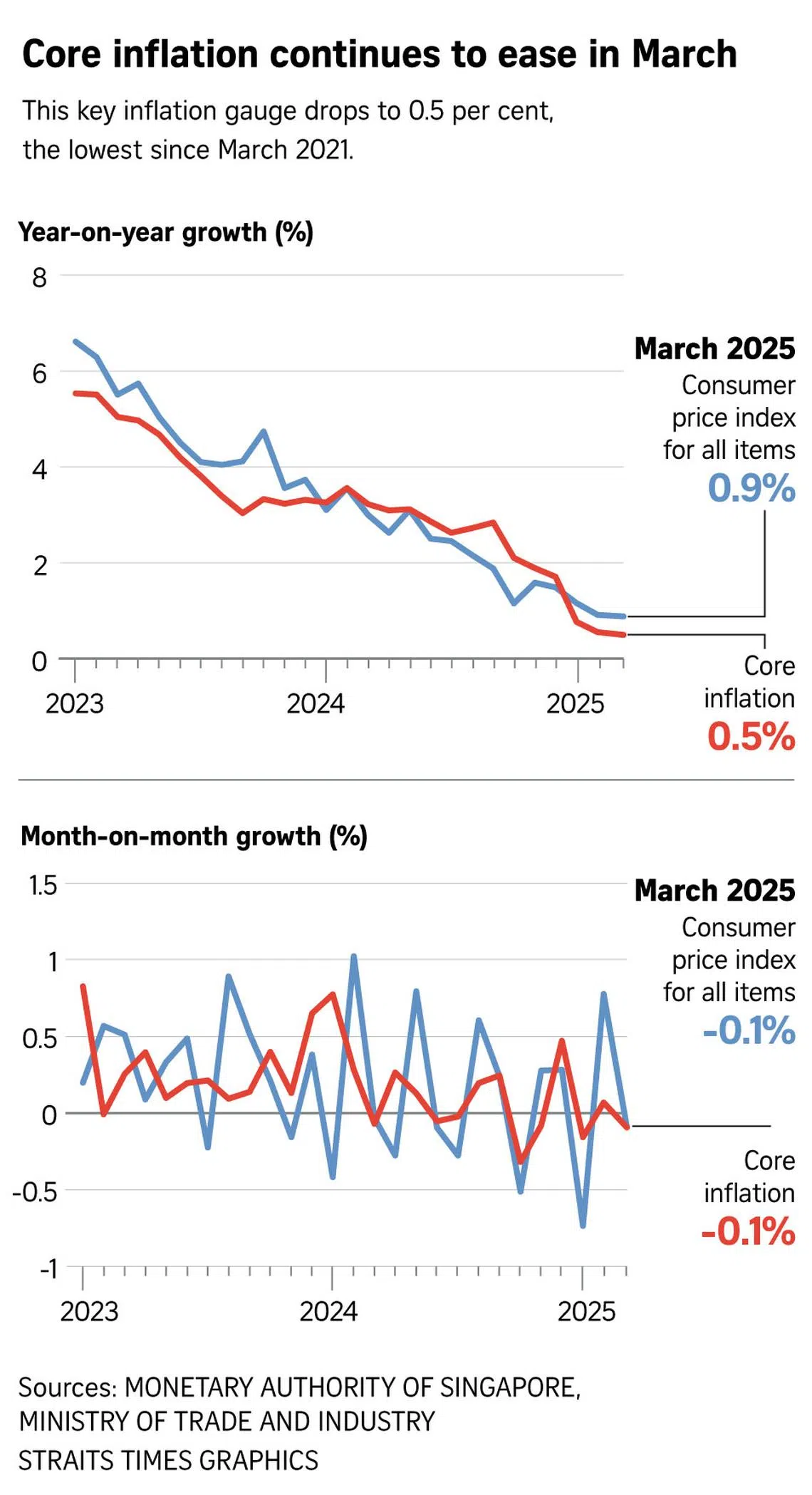Singapore core inflation drops to 4-year low of 0.5% in March; analysts see more downward pressure
Sign up now: Get ST's newsletters delivered to your inbox

Core inflation in March was lower across all broad spending categories other than food.
PHOTO: ST FILE
Follow topic:
SINGAPORE - Singapore’s core inflation dropped for a sixth consecutive month with weaker global demand from trade uncertainty and US tariffs seen putting more downward pressure on consumer prices.
Most spending categories saw smaller year-on-year price increases, while prices fell for two categories – electricity and gas, and retail and other goods – the Monetary Authority of Singapore (MAS) and Ministry of Trade and Industry (MTI) said in a joint report on April 23.
Core inflation, which excludes private transport and accommodation costs to better reflect the expenses of households here, eased to 0.5 per cent year on year, from 0.6 per cent in February.
This is the lowest for the key inflation gauge since March 2021. It also came in lower than a Bloomberg poll forecast of 0.7 per cent.
Overall – or headline – inflation remained unchanged at 0.9 per cent year on year in March, due to higher private transport inflation which offset the fall in core inflation.
But the figure also came in lower than the 1.1 per cent forecast in the Bloomberg poll.
MAS and MTI said Singapore’s imported inflation is expected to remain moderate.
“Although the escalation in trade conflicts could be inflationary for some economies, their impact on Singapore’s import prices is likely to be more than offset by the disinflationary drags exerted by weaker global demand,” they said.
Notably, while they kept to recently lowered 2025 inflation forecasts, they said: “The risks to inflation are tilted towards the downside, given heightened uncertainties in the external environment.”
MAS and MTI also said that unit labour costs are expected to rise gradually, as nominal wage growth slows while productivity increases.
Increased government subsidies for essential services like public healthcare, pre-school education and public transport will also help keep services inflation in check.
MAS on April 14 lowered its core inflation forecast
OCBC Bank chief economist Selena Ling said: “We retain our 2025 headline and core inflation forecasts at 1.2 per cent year on year, but there are downside risks, particularly for core CPI, as it has been lower than expected in the first quarter of 2025.”
DBS Bank senior economist Chua Han Teng said core inflation is expected to remain modest for the rest of 2025, driven by contained imported inflation and a reduced pass-through of business costs to consumer prices.
“Significantly weaker global demand, due to a tariff-induced global economic slowdown, could exert substantial downward pressure on global commodity prices and thus Singapore’s import prices,” he said.
“A global trade slowdown could spill over negatively to Singapore’s export-reliant economy, weakening the domestic labour market and resulting in more subdued domestic cost pressures.”
Maybank Research senior economist Chua Hak Bin said the displacement of China’s excess capacity from US tariffs will be a “major deflationary shock”.
Dr Chua also noted that Singapore faces a low baseline tariff of 10 per cent, and the effective US tariff rate is below 5 per cent as semiconductors, pharmaceuticals and some consumer electronics are exempted for now.
“Manufacturing supply chains may move in favour of Singapore’s, given the lower relative tariffs... Falling interest rates, a construction boom and more fiscal support will help cushion the blow from the trade war,” he said.
“A growth slowdown rather than a recession is likely at this stage.”
March’s inflation report showed that electricity and gas prices dropped 3.5 per cent, after falling 3.1 per cent in February. The report noted that global crude oil prices are seen falling amid slowing global demand and ample supply conditions.
The cost of retail and other goods dropped 0.5 per cent, after falling 0.4 per cent in February. This is due to larger declines in the prices of information and communication equipment as well as household appliances.
Private transport costs rose 2.1 per cent due to larger increases in car prices, up from 1.6 per cent in February.
Food inflation edged up, rising to 1.3 per cent from 1 per cent in February, driven by higher prices for non-cooked food and prepared meals.
Services inflation eased to 0.6 per cent from 0.8 per cent in February.
This was due to a steeper decline in the cost of information and communication services and a more modest increase in point-to-point transport fares.
Accommodation inflation rose at a slower pace at 1.4 per cent from 1.6 per cent in February, due to smaller increases in housing rents.
Ms Sheana Yue, an analyst at research house Oxford Economics, said that deflationary price pressures are expected to persist in 2025.
“An open and trade-reliant economy like Singapore will be affected by weak underlying global demand, which will keep core inflation here muted,” she said.
“On balance, we expect headline inflation to average 0.7 per cent this year from 2.4 per cent last year and for core inflation to average 0.6 per cent from 2.6 per cent. This will provide sufficient space for MAS to loosen policy settings again if necessary to support Singapore’s economy.”



